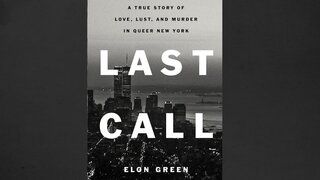Create a free profile to get unlimited access to exclusive videos, breaking news, sweepstakes, and more!
Gay Men Murdered By 'Last Call Killer' Richard Rogers Finally Highlighted In New Book
Author Elon Green paints sincere portraits of serial killer victims Peter Anderson, Thomas Mulcahy, Anthony Marrero, and Michael Sakara while largely ignoring their murderer.

A new book is giving renewed life to four men who were the largely ignored victims of a serial killer who stalked and murdered them during a time of heightened homophobia in the northeast United States in the early 1990s.
Author Elon Green was originally drawn to the series of killings of four men who were murdered between 1991 and 1993 in New York, New Jersey, and Pennsylvania as some of the victims were deeply closeted about their sexuality, as he told Publisher’s Weekly last year.
Green told Oxygen.com this week that he felt after researching their lives, he felt that there were so many stories about the men that he could tell.
Green said that he felt he became deeply connected with them over time. So he devoted most of “Last Call: A True Story of Love, Lust, and Murder in Queer New York” to the lives and personalities of Peter Anderson, 54, Thomas Mulcahy, 57, Anthony Marrero, 44, and Michael Sakara, 55, who were all killed by Richard Rogers Jr.
In turn, he devotes very little of the book to their murderer, who was dubbed “The Last Call Killer.” When he does describe the serial murderer, who was captured in 2001, it's certainly in an unflattering light; he’s described as a quite average person who walked awkwardly. Initially, Green — who has written true-crime fiction for years and at length about “The Doodler”, another largely unknown serial killer who targeted gay men — was not compelled to detail the killer.
“When it came time to write about the murderer, at the beginning I had no interest whatsoever,” he told Oxygen.com. “Eventually I did write about him because I had to fill in the narrative gap, but he was not, and is not, compelling to me.”
But he found the victims “fascinating” and “inspirational.” His book breathes nuance and rich life into the four men, who received little publicity at the time of their deaths. In fact, as Green points out in his book, there still isn’t even a Wikipedia page devoted to the killings.
Marrero, for instance, was a sex worker who wasn't reported missing. Nobody came forward to claim that they even knew him after his body was discovered dismembered and in trash bags near a New Jersey forest. Green expressed frustration that he couldn't detail Marrero further in the book, due to the lack of resources and material.
As for the other three men, he paints a detailed, and sometimes tragic, picture of their lives. Some felt that they had to hide their sexuality from the people that were closest to them. Mulcahy, for instance, was married and a father of four who vanished while visiting New York City on a business trip from Massachusetts. His remains were found dumped at two different rest areas in New Jersey. Mulcahy seemed to have felt comfortable in piano bars, which unfortunately also happened to be where his killer hunted victims.
Green explains that while some jurisdictions involved in the case — both in New Jersey and Pennsylvania — appeared to take the case seriously, he feels like the New York Police Department failed to properly investigate the murder. He attributed this to a likely mix of the NYPD being overwhelmed by high crime rates as well as an institutional bias against queer people.
Additionally, the author said that there was little media coverage of the killings — likely for similar reasons.
“Media organizations did not have a generous view of queer New Yorkers,” he said.
Journalist Donna Minkowitz — known for her coverage of LGBTQ topics and whose reporting inspired the 1999 movie ‘Boys Don’t Cry,” which dramatizes the real-life hate crime murder of trans man Brandon Teena —pitched the story at the Village Voice, but it was rejected, Green noted.
The book also examines how gay people were mistreated during the time of these murders, which coincided with the AIDS epidemic and the resulting bias towards the gay community. He also dove into the risks witnesses and survivors took at the time by seeking out justice.
“They could go to the cops and maybe there’s a small chance [the police] take it seriously, but at the very least, they were going to be deeply embarrassed and maybe lose their job or family if it gets out that they're gay,” he told Oxygen.com. “And all for what? The minuscule percent that this case goes to trial?’
He added that he’s not sure how much society really progressed.
“While at that time, it seems like queer Americans were generally getting the short end of the stick, both in government policy and in the media. I don't think that’s as broadly true as it used to be but now you have trans people basically being s-- on,” he said. “Someone’s ox is always getting gored and that just changes by generation. There are improvements, but they are not across the board.”
For more on this case, watch Oxygen's "The Last Call Killer" coverage from the series "Mark of a Serial Killer."


























